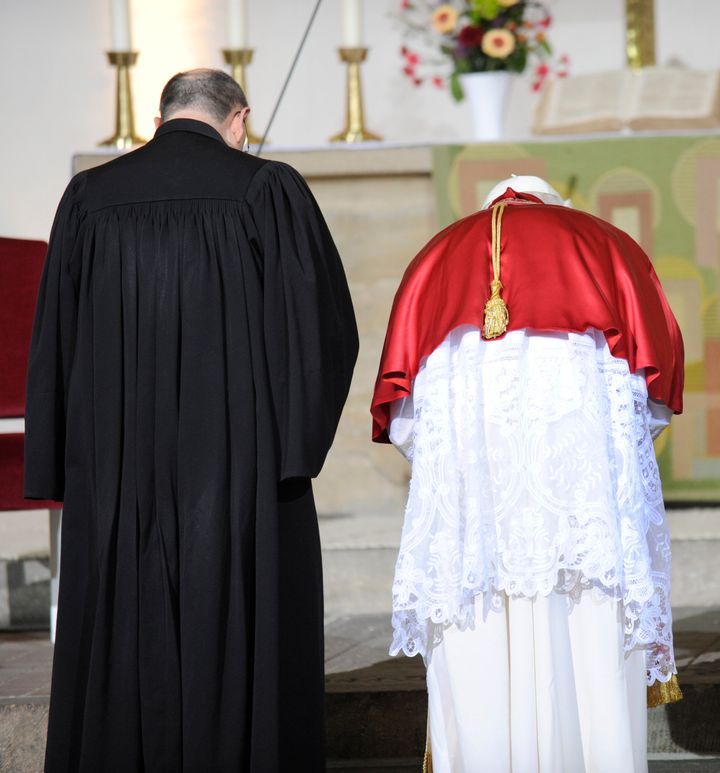
I had been fretting for a few days about whether a black suit would be too formal for the event and in the end I decided on a classic navy pinstripe blazer paired with khakis and a white shirt and tie. I figured since I was traveling up to New England to be with friends from grad school that this ensemble would serve me well, allowing me to blend in with the crowd no matter how staid or solemn the event.
After stopping off to purchase a congratulations card, we were running a bit late. When I entered the church lobby, somebody I recognized ran toward me and said, "Oh good, you're here! The pastor has an alb for you in the sacristy. Go hurry up and put it on and come back out here." I walked over to meet the pastor and he picked up the worn white garment. Sensing that I didn't have much experience vesting, he offered to help. Take off the jacket and slip this on, he told me. After buttoning up the front, he took the cincture, the long piece of rope that serves as a sort of holy belt, and tied it around my waist, leaving enough tassel loose so that the knotted ends would fall just above my shoes when I walked. Any worry I had about my attire no longer mattered; everything was covered in this sacred garb.
I was in Connecticut at a suburban Lutheran church for the ordination ceremony of a close friend who was called to serve a congregation in western Massachusetts. We had met as divinity students; he was on track to be a minister while I opted for a strictly academic route. The school we attended prided itself on its ecumenical nature, and Tim used his small in planning this joint ordination to incorporate this ethos into his ordination. As a result, he asked me, his Roman Catholic friend, to serve as crucifer (some misread the title as crucifier, an admittedly more dramatic role I may have considered had it been offered). I would wear an alb, lead the procession to the altar carrying a wooden cross, and have a prime seat in the sanctuary for the duration of the service.
From that vantage point I was able to see the other ways that the ecumenical spirit animated parts of the service. Many of my classmates had been ordained earlier in the year, and they vested and processed in behind me. Included were a handful of Episcopal priests, a few Congregationalist ministers, and others of various Christian persuasions. All the clergy sat together, their denominational loyalties mostly hidden beneath their uniform chasubles and stoles.
I had learned that ecumenists often lump together Catholics, Lutherans and Episcopalians because their liturgies are fairly similar, and I had attended enough services from each tradition to know that this is basically true. But it had been a couple years since graduation and so I had forgotten just how familiar a Lutheran service would be to my Catholic sensibilities. The opening sequence of prayers and music could have been lifted right from the Roman Missal (but that they were recited by a female bishop reminded me that I was not at Catholic Mass), and the readings were selected by a lectionary shared by many denominations. Responses and music were quite similar, and theological language was nearly identical. We did not pray for Benedict our pope or hope to share in the beatific vision with Mary ever virgin, but the overwhelming sentiment of the service was catholic in the literal sense of the word.
In the days and weeks that followed the ordination, I was filled with a spirit of ecumenism that I had not felt as viscerally since my time in divinity school, and my thoughts again turned to the place of worship in ecumenical efforts. There are many theological issues, some legitimate and some aesthetic and trivial, that keep Catholics and Protestants apart. Figuring out how to bridge these gaps often seems to be the starting point, with the goal of arriving someplace where common worship is possible.
What if we flipped the order?
A good friend who works in the Catholic Church with individuals from opposite ideological spectrums often makes the point that it is more difficult to be distrustful and disparaging of others when you know them personally. If this is true on the personal level, might it work at the denominational level as well? What if Catholics and Protestants were to approach the altar together, sincerely believing that all involved did so in a spirit of reverence and respect, awe and humility?
There would inevitably be some hiccups along the way. Would a Catholic priest feel comfortable concelebrating with a divorced female Episcopal priest? Would an openly gay and partnered minister want to break bread with an ideological opponent? How would Congregationalist and Roman Catholic presiders approach the Eucharist when their theologies are so distant? On a more basic level, what kinds of language would be used? Which core elements of worship services would be included? How would these be chosen?
Catholics and Protestants alike hold certain theological, doctrinal and liturgical traditions sacred, and the real differences among our various Christian tribes should not be casually dismissed or glossed over. But imagine the possibilities if we were able to trust in God enough to set them aside for a bit for a greater purpose. Imagine tearing down barriers, if only for an hour at a time, and worshipping together, with a vision of unity animating our thoughts and words. Perhaps the differences that seem so insurmountable to unity might lessen a bit in intensity after such a service? Though some will dismiss this idea as theologically lightweight and overly romantic, actually being present with one another in worship allows the sincerity and faithfulness of our neighbors to be felt in meaningful and transformative ways.